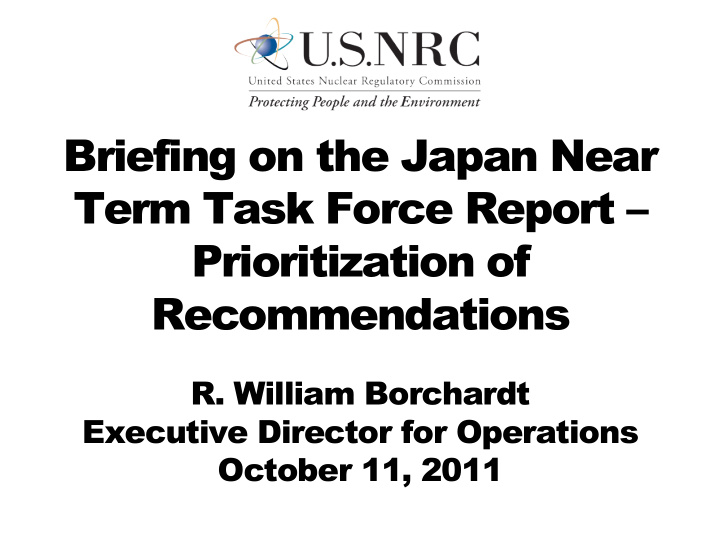



Briefing on the Japan Near Term Task Force Report – Prioritization of Recommendations R. William Borchardt Executive Director for Operations October 11, 2011
Prioritization of Near-Term Task Force Recommendations Eric Leeds Director of the Office of Nuclear Reactor Regulation 2
Agenda • Background • Prioritization of NTTF Recommendations • Additional issues • Resources • Next steps 3
NTTF Conclusions • No imminent risk from continued operation and licensing activities • NTTF report provided 12 overarching recommendations addressing principles of defense-in- depth, protection, mitigation and emergency preparedness 4
Status of SRM-SECY-11-0093 • Required four Notation Vote Papers on NTTF report: – Proposed charter (complete) – Staff recommendations (complete) – Prioritization (complete) – Recommendation 1 (due within 18 months) 5
Staff Review of NTTF Recommendations • Commission paper (SECY-11-0124) contains staff’s assessment of the NTTF recommendations that can and, in the staff’s judgment, should be initiated, in part or in whole, without delay 6
Prioritization of NTTF Recommendations • Commission paper (SECY-11-0137) contains staff’s prioritization of the NTTF recommendations, including: – Recommended regulatory actions – Implementation challenges – Technical and regulatory bases – Additional recommendations – Schedule and milestones 7
Three Tiers of Recommendations • Tier 1 – Start without delay • Tier 2 – Start in the near term • Tier 3 – Longer term actions 8
Tier 1 Recommendations • Recommendations which should be started without unnecessary delay and for which sufficient resource flexibility, including availability of critical skill sets, exists 9
Tier 1 Recommendations • Seismic and flood hazard reevaluations (2.1) • Seismic and flood walkdowns (2.3) • Station blackout (4.1) • 10 CFR 50.54(hh)(2) equipment (4.2) 10
Tier 1 Recommendations (cont’d) • Reliable hardened vent for Mark I and Mark II containments (5.1) • SFP instrumentation (7.1) • Strengthening on-site emergency response capabilities (8) • Emergency preparedness (9.3) 11
Additions to Tier 1 • Reliable Mark II Containment Vents – Concurrent with Mark I (5.1) • SFP Instrumentation (7.1) – Interact with stakeholders regarding functional requirements – Issue order requiring implementation 12
Tier 2 Recommendations • Recommendations which could not be initiated without delay due to factors that include: – Need for further technical assessment and alignment – Dependence on Tier 1 issues – Availability of critical skill sets 13
Tier 2 Recommendations • SFP makeup capability (7.2, 7.3, 7.4, and 7.5) • Emergency preparedness (9.3) – Remaining portions with the exception of ERDS capability 14
SFP Makeup Capability (7.2, 7.3, 7.4, and 7.5) • Engage stakeholders in support of rulemaking activities to provide reliable SFP instrumentation and makeup capabilities • Development of regulatory basis, proposed rule and implementing guidance 15
Emergency Preparedness (9.3) • Tier 2 - remaining portions with the exception of ERDS capability • Engage stakeholders on planning standard elements • Issue order requiring necessary changes 16
Tier 3 Recommendations • Require further staff study • Follow after Tier 1 actions • Depend on critical skill set availability • Depend on resolution of NTTF Recommendation 1 17
Tier 3 Recommendations • Ten-year confirmation of seismic and flooding hazards (2.2) • Seismically induced fires and floods (3) • Reliable hardened vents for other containment designs (5.2) • Hydrogen control (6) 18
Tier 3 Recommendations (cont’d) • EP for prolonged SBO and multiunit events (9.1, 9.2, 10) • Enhanced ERDS capability (9.3) • EP-related decision-making, radiation monitoring, and public education (11) 19
Tier 3 Recommendations (cont’d) • Reactor Oversight Process modifications (12.1) • Staff training on severe accidents, including SAMGs (12.2) 20
Additional Issues • Additional issues identified by external stakeholders and NRC staff – Disciplined assessment of relationship to Fukushima lessons learned – Future assessment and potential prioritization 21
Additional Issues • Filtration of containment vents • Instrumentation for seismic monitoring • Basis of emergency planning zone size 22
Additional Issues (cont’d) • Prestaging of potassium iodide beyond ten miles • Transfer of spent fuel to dry cask storage • Loss of ultimate heat sink 23
Resources • Tier 1 and Tier 2 estimates – Fiscal Year 2012 – 30 FTE – Fiscal Year 2013 – 90 FTE – Total (including out years) – 205 FTE 24
Next Steps • Evaluate Tier 3 schedules and resource impacts • Identify and provide prioritization of additional issues • Provide options regarding NTTF Recommendation 1 25
Acronyms • EP – Emergency Preparedness • ERDS – Emergency Response Data System • FTE – Full-Time Equivalents • NTTF – Near-Term Task Force • SAMG – Severe Accident Mitigation Guidelines • SBO – Station Blackout • SFP – Spent Fuel Pool 26
Recommend
More recommend